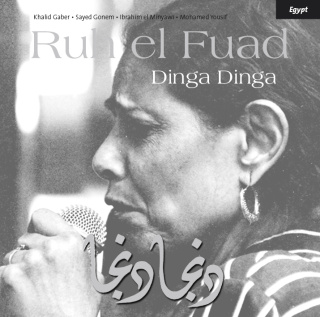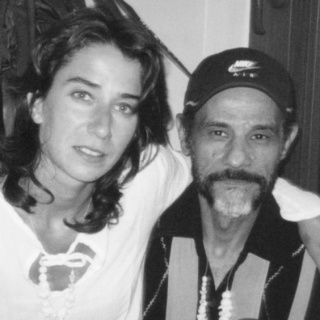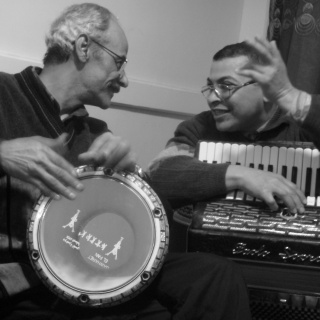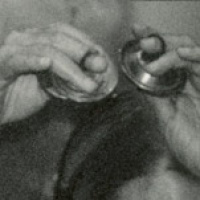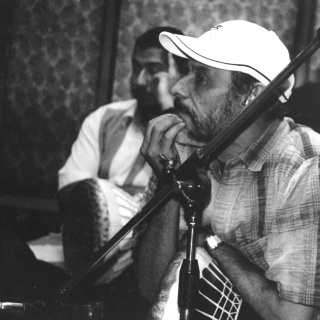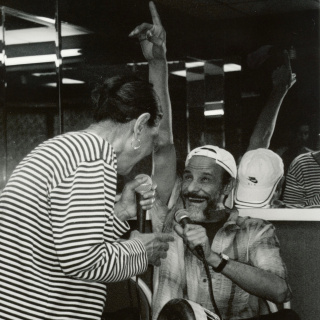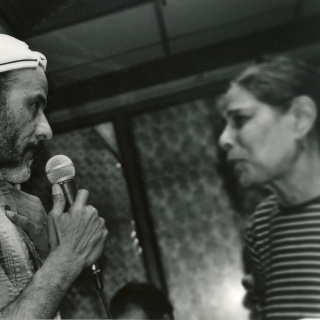dance, music, body wisdom from egypt
Dinga Dinga with the great baladi singer Ruh el Fuad and her ensemble was captured in Cairo´s foremost sound recording studio in June 2005.
The voice of Ruh El Fuad brings us the beauty of baladi music with a new version of her famous piece “dinga dinga”, mesmerizing mawaweel (improvisations of the voice), and songs from the traditional baladi repertoire of Egypt. Dinga Dinga is a must-have for passionate world music afficionados, dancers, and lovers of Egypt.
voice: Ruh El Fuad
percussion: Ibrahim El Minyawi, Ali El Minyawi, Qtb El Minyawi, Osman Ali
sax/clarinet: Mohamed Yousif
nay: Sayed Gonem
accordeon: Khaid Gaber
total playing time: 40 mins
production: tanz raum label 2005
Price: 22.00 €
The idea of re-recording Dinga Dinga was born a long time ago when the only version to be found on the market was an awful mix of the wonderful voice of Ruh el Fuad, saturated synthesisers and yelling instruments whose unique objective was to give a false modern touch to the music. We were already acquainted with the voice of Ruh el Fuad, thanks to her first recorded live disk “Spirit of the Heart”. This superb recording deserved to be followed by another one, done in a studio and whose goal was to make a version of Dinga Dinga worthy of her voice and worthy of the musical tradition of Egypt, with the instruments of the Baladi repertory, and respecting the original musical structure.
It is thanks to Ibrahim el Minyawi that this project has come about. He brought together within a very short length of time outstanding musicians. Each of them was chosen for his musical talent and for his knowledge of the Baladi musical tradition, essential musical conditions to bring out the best in the voice of Ruh el Fuad. Ten musicians were gathered together : accordion, saxophone, clarinet, flute, tabla, doff, dahula, sagates and male voices. And so the project started in the fine music studio of Cairo, in the Doqqi area, well known by all musicians and which belongs to Oum Kalthoum Req player, Mohamed el Arabi.
Ruh was nervous, of course, but she didn’t lose any of her charisma. As she hadn’t sung for a long time, she was scared that her voice would betray her. Once the instruments were tuned, she could finally have a go … What a wonderful surprise! Her voice and her talent were present, intact, including all the variations, improvisations and musical modes, her voice only needed the accompaniment of good musicians and good muses… Then began hours and hours of rehearsal that ended in the recital which involved finding the perfect balance between the musicians and the singer, without pretentiousness, but with generosity and respect, in the service of music.
Then came the day of recording, a Friday, in one of the best recording studios of Cairo, the “music voice”, a perfect-technology studio, where we met again Ihab Ragab, the sound technician whom we had known for a while and whom we had worked with for the Azraq and Monaga CDs. Ihab Ragab understands his art and knows the essential conditions for good recording.
First piece: Dinga Dinga. After the introduction, Mohamed starts the first improvisation with the clarinet. This is a crucial moment as he makes the transition between the instrumental introduction and the moment when the voice starts singing. As the music is, for the most part, improvised, each instrument has to pay attention and be constantly ready to enter the music, in order to carry the voice of Ruh. This complex stylistic exercise demands a faultless performance as it is impossible to start the piece again in the middle. After a few hesitating starts, the instruments get used to each other and find their marks. And finally the music can take its full place. The magic is there, the instruments harmonise together and embrace with each of their talents the complex repertory in which Ruh’s voice blossoms, and takes us away to the popular, Baladi streets of Cairo.
The photographer of these black and white shots is Caroline Chevat. She took them during the rehearsals in the sound studio.
